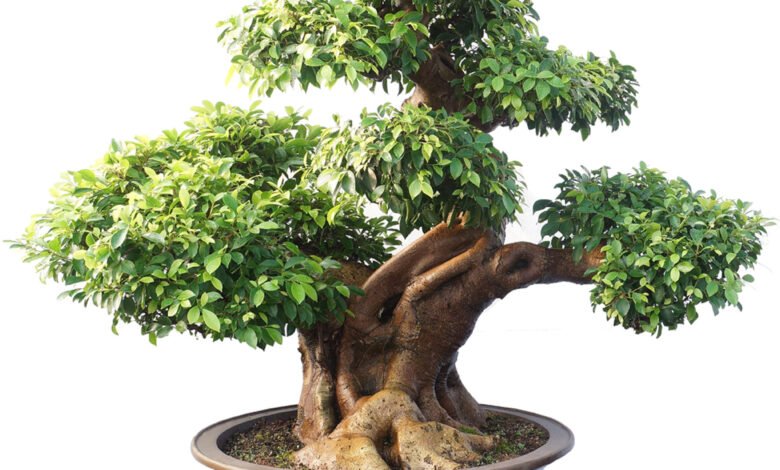
Ficus retusa, commonly known as the Ginseng Ficus, is a popular species of the Ficus genus, widely appreciated for its unique appearance and ease of care. Known for its thick, knobby roots, glossy green leaves, and adaptability to indoor environments, Ficus retusa has become a favorite among bonsai enthusiasts and gardeners alike. Whether you’re a seasoned gardener or a beginner looking to cultivate a beautiful bonsai, Ficus retusa is an excellent choice that offers both aesthetic appeal and low-maintenance care.
Key Features of Ficus Retusa
- Distinctive Roots and Trunk
One of the most striking features of Ficus retusa is its thick, gnarled roots, which resemble the shape of the ginseng root, giving the tree its alternative name, Ginseng Ficus. The roots are often exposed above the soil, creating a dramatic and unique look that is highly sought after in bonsai culture. The tree’s trunk also has a smooth, robust appearance that contrasts with the rough texture of the roots. - Glossy, Oval Leaves
Ficus retusa has glossy, oval-shaped leaves that are a vibrant green color. The leaves grow in clusters and maintain their rich color year-round, providing the tree with a full, lush appearance. This feature makes it an ideal choice for bonsai, as the leaves create a dense canopy, contributing to the tree’s aesthetic appeal. - Compact Growth Habit
As a species that thrives as a bonsai, Ficus retusa has a naturally compact growth habit. It doesn’t grow as large as some other Ficus species, making it suitable for small pots and indoor spaces. The tree’s low-maintenance care and small size make it a perfect option for bonsai beginners and experienced enthusiasts who prefer smaller plants.
Growing and Caring for Ficus Retusa
Ficus retusa is relatively easy to grow, provided you give it the right conditions. Here are a few key care tips to help you keep your tree healthy and thriving:
- Light Requirements
Ficus retusa thrives in bright, indirect light. It can tolerate some direct sunlight, but too much can scorch its leaves. For indoor cultivation, place your Ginseng Ficus near a window with filtered light. If you’re growing it outdoors, choose a location with partial shade to ensure it gets the right amount of light. - Watering Needs
Ficus retusa prefers regular watering, but it’s crucial not to overwater the tree. Allow the top inch of soil to dry out between waterings. Be sure the pot has good drainage to prevent water from accumulating in the roots, which can lead to root rot. During the growing season (spring and summer), the tree may need more frequent watering, but in the winter months, reduce watering as its growth slows. - Temperature and Humidity
Ficus retusa is a tropical plant that enjoys warm temperatures. It thrives in temperatures between 60-80°F (16-27°C). This tree also appreciates moderate humidity, which is why it does well in bathroom environments or with the use of a humidity tray. If you live in a dry area, consider using a humidifier to maintain the right moisture levels in the air. - Soil and Fertilization
A well-draining, loamy soil mix is ideal for Ficus retusa. A mix designed for bonsai or indoor plants, combined with sand or perlite, ensures proper drainage. During the growing season, feed your Ficus retusa with a balanced, water-soluble fertilizer every 4-6 weeks. Reduce fertilization in the fall and winter months when the plant’s growth slows down. - Pruning and Shaping
Pruning and shaping are essential to maintaining the desired appearance of Ficus retusa, especially for bonsai enthusiasts. Regular pruning encourages compact growth and helps the tree maintain its small size. Pinching back new growth is effective in promoting branch development and keeping the plant full. Be sure to use clean, sharp tools to avoid damaging the plant.
Benefits of Ficus Retusa
- Ideal for Bonsai
Ficus retusa’s compact growth habit and striking root structure make it a top choice for bonsai cultivation. It adapts well to bonsai techniques and can be easily shaped into various forms, such as informal upright, slanting, or cascading styles. - Low-Maintenance
Unlike some other bonsai species, Ficus retusa is known for being relatively low-maintenance. It doesn’t require as much attention to humidity or temperature fluctuations, making it an excellent option for people who are new to bonsai care or those who want an easy-to-care-for indoor plant. - Air-Purifying Properties
Like many other Ficus species, Ficus retusa has air-purifying qualities, making it a beneficial plant for improving indoor air quality. The tree can help filter out toxins from the air, creating a healthier living environment.
Conclusion
Ficus retusa is a beautiful and versatile plant, admired for its unique gnarled roots, glossy leaves, and compact growth. As a bonsai tree, it is ideal for both beginners and seasoned enthusiasts due to its low-maintenance care and ability to thrive in indoor environments. With proper light, watering, and occasional pruning, this tree will flourish and bring elegance to any space. Whether you’re looking for a stunning indoor plant or a bonsai tree with spiritual symbolism and aesthetic beauty, Ficus retusa is an excellent choice.


One Comment